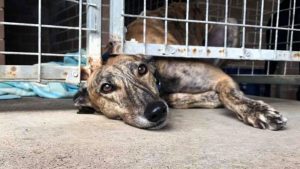Evidence demonstrates that most greyhounds are kept under inadequate conditions that fail to meet their physiological, behavioural and social needs.
Greyhounds, like all dogs, are social animals. The recognised critical socialisation period is 3-18 weeks which is when greyhound puppies should be safely exposed to as many new sensations as possible. Of the 60% of whelped puppies that enter a race kennel, a significant number have spent most of their time in a paddock with very limited contact with people.
This lack of socialisation leads to fear, anxiety, phobias and anti-social behaviour. Once greyhounds reach the racing kennel there is very little opportunity for mental stimulation, play or quality of life. Many greyhounds are kept in cramped, barren, single-dog kennels with no opportunity to socialise with people or other dogs.
For example, the NSW Greyhound Welfare Code of Practice specifies that a greyhound can be kept in a pen that is 1.2 x 1.8 metres and exercised for only 30 minutes a day. Animal welfare groups see this as unacceptable and in contravention of one of the Five Freedoms as defined by the RSPCA: “Freedom to express normal behaviour: by providing sufficient space, proper facilities and company of the animal’s own kind.”
- the routine use of inhumane anti-barking muzzles and
- the poor body condition in which greyhounds that aren’t making money for their owners are kept – see CPG survey here.
Evidence
- RSPCA Knowledgebase:What is the RSPCA’s view on greyhound racing
- Barking Muzzles: a common form of abuse
- Saving Rita: a story of exploitation, neglect and abuse
- Draft NSW Greyhound Welfare Code of Practice
- RSPCA Knowledgebase: What are the Five Freedoms of animal welfare
- May 25, 2022 – VICE Australia, Australian Greyhounds Are Still Brutally Neglected By Their Trainers, Advocates Say, Julie Fenwick


